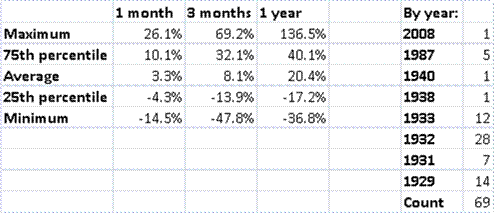Recently I received an e-mail from one of my readers on my investing methods.? I thought it might be useful for all of my readers, so I am going to answer it here.
Note: the links are to posts that I think he meant.? If not, my apology.
P/E:??You use?three different P/E criteria, which makes P/E very important in your strategy.??Why do you?use P/E as opposed to P/Cash flow, which many believe is more telling than P/E???Do you have any concern in using forward P/E ratios, considering that analysts are notorious for being wrong with their earnings predictions (David Dreman?discusses this in his books)?
Ideally, we want an accurate forward estimate of free cash flow.? No one knows that, so I have to compromise.? P/E did have three spots in my April post, but that gave it a weight of 3/13ths.? Why not cash flow?? I’m open to the concept, and I have used it in the past.? In tough markets where M&A is not happening, CFO and EBITDA measures tend not to work as well.? I give forward P/Es higher weights when we are in the beginning of a recovery, with corporate bond spreads starting their rally.? Once the rally is established, and spreads have tightened, that is when M&A heats up, that is when EV/EBITDA, and P/CFO metrics have more punch.? During bear phases, I give more weight to P/B and P/Sales.
I’ve talked with a lot of different investment managers, and some like trailing P/Es and others, forward P/Es.? In general, the sell side is optimistic, but there is an advantage to using their estimates.? They provide a control mechanism.? Their estimates drive stock performance in the short run and they provide a gauge to how results are tracking against expectations.? I think that their estimates reflect the view of the market as a whole usually.? I try to balance optimistic and pessimistic indicators in my valuations, so as not to overplay either side.
Net Operating Accruals:? Do you use this metric based on the research done by Sloan and used in Piotroski’s Z_score?
No, I got this through Hirshleifer and a number of other financial economists.? That doesn’t mean that it might not be the same thing researched by Sloan and Piotroski.? Piotroski’s Z-score has a lot to commend it; the only trouble is that very few companies get those high scores.
Volatility, RSI, Neglect:? These are metrics that I have seen few people discuss. ?What is?your basis for using them? I believe I read an abstract to a?study that found that low volatility stocks outperform high volatility stocks- is this what you are trying to take advantage of???What is the measurement for neglect anyway???Sorry for my lack of knowledge on this subject.? When I read this post I was suprised that, as a contrarian fundamental investor,?you used so many technical metrics.? Do you try to use metrics that have?very little following because?methodologies lose their?effectiveness when?they becomes popular (like the small cap effect)?
What is a technical indicator?? I don’t read charts.? I do try to look for stocks that are off the beaten path, and there are some non-price measures that indicate that.? As for volatility, I would point you to this article at the excellent CXO Advisory blog.? Yes, low volatility tends to outperform.
It’s not that I am looking at technicals, but anomalies.? I believe in the Adaptive Markets Hypothesis, which says that inefficiencies exist in the markets, but only for a while because when they are big enough, investors take advantage of them, and compete them away.? The markets are only mostly efficient, and I try to take advantage of what is “on sale” when I reshape my portfolio.
The neglect measure is what fraction of the company’s shares trade.? In general, companies with lower share turnover tend to do better.
As for RSI, that is one area where I have changed.? I used to use momentum as “buy what’s falling” metric.? There’s too much evidence for the contrary, and so I have flipped RSI so that weight is given to stocks with positive momentum.? Positive momentum tends to generate positive returns, because people are conservative in their estimates.? Buying momentum makes sense except when many are doing it.? After things have been running hot for a while, I would drop the metric.
What helps me go where others will not are my industry models.? One of my core beliefs is that industries are under-analyzed.? Also, Industry behavior is more basic to the market than size and value/growth distinctions.? If I analyze industries that are out of favor, and buy financially strong names in those industries, it is difficult to go wrong.
When I look at anomalies, I look for things where retail and professional investors tend to err.? Those are places where human nature tends to encourage people to make wrong decisions.? People like to play controversial stocks — they tend to be overvalued.? People like to play well-known stocks.? They are overvalued as well.? Momentum?? The market as a whole is slow to react to new data.
I don’t aim for metrics with small followings.? I aim for things that have worked over time.? Before the calculation of the metrics, my industry models toss in a number of out-of-favor names.? After the calculation of the metrics, I look at earnings quality, frequency of beating estimates, a more detailed look at the balance sheet, etc.
I view my non-fundamental variables as measures that complement the valuation side of the analysis.? (Valuation is most important, but it is not everything.)? They help in avoiding value traps (net operating accruals), and point at stocks that other investors are ignoring.? They aren’t perfect, and if they were perfect, I am sure that I don’t use them perfectly.? The object is to tilt the odds in my favor of having a successful investment.? That is what my screening methods (rule 8 ) intend to do, as well as the rest of my eight rules.



